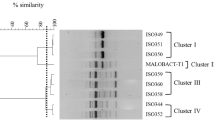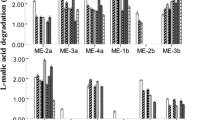Abstract
The objective was to isolate lactic acid bacteria (LAB) from southern Brazil’s wines and investigate their potential as starter cultures for malolactic fermentation (MLF) in Merlot (ME) and Cabernet Sauvignon (CS) wines through the fermentative capacity. The LAB were isolated from CS, ME, and Pinot Noir (PN) wines in the 2016 and 2017 harvests and evaluated for morphological (color and shape of the colonies), genetic, fermentative (increase in pH, acidity reduction, preservation of anthocyanins, decarboxylation of L-malic acid, yield of L-lactic acid, and content of reduced sugars), and sensory characteristics. Four strains were identified as Oenococcus oeni [CS(16)3B1, ME(16)1A1, ME(17)26, and PN(17)65], one as Lactiplantibacillus plantarum [PN(17)75], and one as Paucilactobacillus suebicus [CS(17)5]. Isolates were evaluated in the MLF and compared to a commercial strain (O. oeni), as well as a control (without inoculation and spontaneous MLF), and standard (without MLF). CS(16)3B1 and ME(17)26 isolates finished the MLF for CS and ME wines, respectively, after 35 days, similar to the commercial strain, and CS(17)5 and ME(16)1A1 isolates ended the MLF in 45 days. In the sensory analysis, ME wines with isolated strains received better scores for flavor and overall quality than the control. Compared to the commercial strain, CS(16)3B1 isolate obtained the highest scores for buttery flavor and taste persistence. CS(17)5 isolate received the higher scores for a fruity flavor and overall quality and the lowest for a buttery flavor. The native LAB displayed MLF potential, regardless of the year and grape species from which they were isolated.


Similar content being viewed by others
References
Bailey J, Ollis D (1986) Fundamentals of biochemical Engineering. McGraw-Hill College, New York
Binati RL (2015) Evaluation of malolactic fermentation in high altitude wines with selected autochthonous lactic acid bacteria. Dissertation, Universidade Federal de Santa Catarina
Bokulich NA, Thorngate JH, Richardson PM, Mills DA (2014) Microbial biogeography of wine grapes is conditioned by cultivar, vintage, and climate. Proc Natl Acad Sci 111:139–148. https://doi.org/10.1073/pnas.1317377110
Bou M, Powell C (2005) Strain selection techniques. Malolactic fermentation in wine. Lallemand Inc., Canadá, pp 49–56
Bravo-Ferrada BM, Hollmann A, Brizuela N, Hens DV, Tymczyszyn E, Semorile L (2016) Growth and consumption of L-malic acid in wine-like medium by acclimated and non-acclimated cultures of Patagonian Oenococcus oeni strains. Folia Microbiol 61(5):365–373. https://doi.org/10.1007/s12223-016-0446-y
Brizuela N, Tymczyszyn EE, Semorile LC, La Hens DV, Delfederico L, Hollmann A, Bravo-Ferrada B (2019) Lactobacillus plantarum as a malolactic starter culture in winemaking: a new (old) player? Electron J Biotechnol 38:10–18. https://doi.org/10.1016/j.ejbt.2018.12.002
Cibrario A, Peanne C, Lailheugue M, Campbell-Sills H, Dols-Lafargue M (2016) Carbohydrate metabolism in Oenococcus oeni: a genomic insight. BMC Genomics 17:984. https://doi.org/10.1186/s12864-016-3338-2
Cliff MA, King MC, Schlosser J (2007) Anthocyanin, phenolic composition, colour measurementand sensory analysis of BC commercial red wines. Food Res Int 40:92–100. https://doi.org/10.1016/j.foodres.2006.08.002
Doyle J, Doyle JL (1987) Isolation of plant DNA from frech tissue. Focus 12:13–15
Fernando N, Araque I, Ortís A, Thornes G, Bautista-Gallego J, Bordons A, Reguant C (2020) Evaluating the effect of using non-Saccharomyces on Oenococcus oeni and wine malolactic fermentation. Food Res Int 138:109779, Part B. https://doi.org/10.1016/j.foodres.2020.109779
Fontan RCI, Veríssimo LAA, Bonomo RCF, Veloso CM (2011) Kinetics of alcoholic fermentation in the elaboration of watermelon wine. B CEPPA 29:203–210
Gambaro A, Varela P, Boido E, Gimenez A, Medina K, Carrau F (2003) Aroma characterization of commercial red wines of Uruguay. J Sens Stud 18:353–366. https://doi.org/10.1111/j.1745-459X.2003.tb00394.x
Garai-Ibade G, Dueñas MT, Irastorza A, Sierra-Filardi E, Werning ML, López P, Corbi AL, Fernández PP (2010) Naturally occurring 2-substituted (1,3)-b-D-glucan producing Lactobacillus suebicus and Pediococcus parvulus strains with potential utility in the production of functional foods. Bioresour Technol 101(23):9254–9263. https://doi.org/10.1016/j.biortech.2010.07.050
Gloria MBA, Hui YH (2005)CRC Press, Austrália,p 38
Goldner MC, Zamora MC (2010) Effect of polyphenol concentrations on astringency perception and its correlation with gelatin index of red wine. J Sens Stud 25:761–777. https://doi.org/10.1111/j.1745-459X.2010.00304.x
Hammer Ø, Harper DAT (2006) Paleontological Data Analysis. Blackwells, Oxford, p 351
Ibarburu I, Puertas AI, Berregi I, Rodríguez-Carvajal MA, Prieto A, Dueñas MT (2015) Production and partial characterization of exopolysaccharides produced by two Lactobacillus suebicus strains isolated from cider. Int J Food Microbiol 214:54–62. https://doi.org/10.1016/j.ijfoodmicro.2015.07.012
IBGE (2020) Systematic survey of agricultural production. Available in: <https://sidra.ibge.gov.br/home/lspa/brasil. Accessed in March 2021
Ines A, Tenreiro T, Tenreiro R, Mendes-Faia A (2009) Review: lactic acid bacteria in wine. Cienc Tec Vitivinic 24(1):1–23. https://www.researchgate.net/publication/262699937
Krieger S, Morenzoni R (2005)Lallemand Inc., Canadá,15–24
Lee S-J, Lee J-E, Kim H-W, Kim SS, Koh K-H (2006) Development of korean red wines using Vitis labrusca varieties: instrumental and sensory characterization. Food Chem 94:385–393. https://doi.org/10.1016/j.foodchem.2004.11.035
Lerena MC, Rojo MC, Sari S, Mercado LA, Krieger-Weber S, Combina M (2016) Malolactic fermentation induced by Lactobacillus plantarum in Malbec wines from Argentina. South Afr J Enol Vitic 37(2):115–123
López R, López-Alfaro I, Gutiérrez AR, Tenorio C, Garijo P, González-Arenzana L, Santamaría P (2011) Malolactic fermentation of Tempranillo wine: contribution of the lactic acid bacteria inoculation to sensory quality and chemical composition. Int J Food Sci Technol 46:2373–2381. https://doi.org/10.1111/j.1365-2621.2011.02759.x
Lorentzen MPG, Lucas PM (2019) Distribution of Oenococcus oeni populations in natural habitats. Appl Microbiol Biotechnol 103(7):2937–2945. https://doi.org/10.1007/s00253-019-09689-z
Mamlouk D, Hidalgo C, Torija MJ, Gullo M (2011) Evaluation and optimization of bacterial genomic DNA extraction for no-culture techniques applied to vinegars. Food Microbiol 28:1374–1379. https://doi.org/10.1016/j.fm.2011.06.009
Manera C, Olguin NT, Bravo-Ferrada BM, Tymczyszyn EE, Delfederico L, Bibiloni H, Caballero AC, La SemorileL DV (2019) Survival and implantation of indigenous psychrotrophic Oenococcus oeni strains during malolactic fermentation in a Patagonian Pinot noir wine. LWT - Food Sci Technol 108:353–360. https://doi.org/10.1016/j.lwt.2019.02.063
Meilgaard M, Civille GV, Carr BT (2015) Sensory evaluation techniques, 5 edn. CRC Press, Boca Raton, p 448
Merkytè V, Longo E, Windisch G, Boselli E (2020) Phenolic compounds as markers of wine quality and authenticity. Foods 9:1785. https://doi.org/10.3390/foods9121785
Miele A (2021) Wine composition of Merlot and Cabernet Sauvignon vine clones under the environmental conditions of Serra Gaúcha, Brazil. Food Sci Technol 41(1):1–7. https://doi.org/10.1590/fst.10520
Miele A, Rizzon LA (2019) Rootstock-scion interaction: 4. Effect on the sensory characteristics of Cabernet Sauvignon wine. Rev Bras Frutic 41(1):43. https://doi.org/10.1590/0100-29452019043
Miele A, Rizzon LA, Zanus MC (2010) Discrimination of brazilian red wines according to the viticultural region, varietal, and winery origin. Food Sci Technol 30(1):268–275. https://doi.org/10.1590/S0101-20612010000100039
Miotto SPS, Fensterseifer LC, Gava A, Rossato SB, Ficagna E, Cansian RL, Valduga E (2018) Isolamento de bactérias ácido láticas da serra Gaúcha e seu potencial para a fermentação malolática. Rev Bras Viticult Enol 10:94–101. https://doi.org/10.22533/at.ed.43521100511
OIV, International Organization of Vine and Wine (2018) Compendium of international methods of analysis of wines and musts. Available in: http://www.oiv.int/en/technical-standards-and-documents/methods-nalysis/compendium-international-methodsanalysis-wines-and-musts-2-vol. Accessed in Apr. 2021
Oliveira LC (2011) Chemical and sensory evaluation of red wines produced in the regions of Vale do São Francisco and Serra Gaúcha. Dissertation. Federal University of Bahia. 2011
Puertas AI, Arahal DR, Ibarburu I, Elizaquível P, Aznar R, Dueñas MT (2014) Lactobacillus sicerae sp. nov., a lactic acid bacterium isolated from spanish natural cider. Int J Syst Evol Microbiol 64(9):2949–2955. https://doi.org/10.1099/ijs.0.059980-0
Puertas AI, Ibarburu I, Elizaquivel P, Zuriarrain A, Berregi I, López P, Prieto A, Aznar R, Dueñas MT (2018) Disclosing diversity of exopolysaccharide-producing lactobacilli from spanish natural ciders. LWT - Food Sci Technol 90:469–474. https://doi.org/10.1016/j.lwt.2017.12.048
Ribéreau-Gayon P (2003) Tratado de enología: química del vino, estabilización y tratamientos. Buenos Aires: Hemisfério Sur 2:537
Rizzon LA (2010) Methodology for wine analysis. Brasília, DF, Embrapa Technological Information, 120p edn. Embrapa Grape and Wine, Bento Gonçalves
Rizzon LA, Miele A (2009) Analytical characteristics of Merlot wines from “Serra Gaúcha. Cienc Rural 39(6):1913–1916. https://doi.org/10.1590/S0103-84782009005000109
Rodas AM, Ferrer S, Pardo I (2003) 16S-ARDRA, a tool for identification of lactic acid bacteria isolated from grape must and wine. Syst Appl Microbiol 26(3):412–422. https://doi.org/10.1078/072320203322497446
Rottava I (2010) Selection of microorganisms and optimization of monoterpene biotransformation. Thesis. Universidade Federal do Rio de Janeiro
Sáenz-Navajas MP, Campo E, Fernández-Zurbano P, Valentin D, Ferreira V (2010) An assessment of the effects of wine volatiles on the perception of taste and astringency in wine. Food Chem 121:1139–1149. https://doi.org/10.1016/j.foodchem.2010.01.061
Solieri L, Genova F, De Paola M, Giudici P (2010) Characterization and technological properties of Oenococcus oeni strains from wine spontaneous malolactic fermentations: a framework for selection of new starter cultures. J Appl Microbiol 108:285–298. https://doi.org/10.1111/j.1365-2672.2009.04428.x
Tsanova-Savova S, Ribarova F (2002) Free and conjugated myricetin, quercetin, and kaempferol in bulgarian red wines. J Food Compost Anal 15:639–645. https://doi.org/10.1006/jfca.2002.1099
Vasconcelos NM, Pinto GAS, Aragão FAS (2013) Determination of reducing sugars by 3,5 dinitrosalicylic acid: history of method development and establishment of a protocol for the bioprocess laboratory. Embrapa Agroindústria Tropical. Research and Development Bulletin, p 25
Wang S, Li S, Zhao H, Gu P, Chen Y, Zhang B, Zhu B (2018) Acetaldehyde released by Lactobacillus plantarum enhances accumulation of pyranoanthocyanins in wine during malolactic fermentation. Food Res Int 108:254–263. https://doi.org/10.1016/j.foodres.2018.03.03226
Zavaleta AI, Martínez-Murcia AJ, Rodríguez-Valera F (1997) Intraspecific genetic diversity of Oenococcus oeni as derived from DNA fingerprinting and sequence analyses. Appl Environ Microbiol 63:1261–1267. https://doi.org/10.1128/aem.63.4.1261-1267.1997
Acknowledgements
The authors thank the Coordination for the Improvement of Higher Education Personnel (CAPES), National Council for Scientific and Technological Development (CNPq), Research Support Foundation of the State of Rio Grande do Sul (FAPERGS), Federal Institute of Education, Science and Technology of Rio Grande do Sul (IFRS) and Regional Integrated University of Alto Uruguai e das Missões (URI Erechim).
Author information
Authors and Affiliations
Contributions
S.P.S.M, E.V, and R.L.C conceptualized the work. All authors analyzed, interpreted the data, and wrote the manuscript. All authors read and approved the final manuscript.
Corresponding author
Ethics declarations
Competing Interests
The authors have no relevant financial or non-financial interests to disclose.
Additional information
Publisher’s Note
Springer Nature remains neutral with regard to jurisdictional claims in published maps and institutional affiliations.
Electronic supplementary material
Below is the link to the electronic supplementary material.
Table S1
Descriptor terms, definitions and references used in the training stage of tasters for red wine
Rights and permissions
Springer Nature or its licensor (e.g. a society or other partner) holds exclusive rights to this article under a publishing agreement with the author(s) or other rightsholder(s); author self-archiving of the accepted manuscript version of this article is solely governed by the terms of such publishing agreement and applicable law.
About this article
Cite this article
Miotto, S.P.S., Fensterseifer, L.C., de Souza Hassemer, G. et al. Malolactic fermentation of lactic acid bacteria isolated from southern Brazilian red wine. World J Microbiol Biotechnol 39, 201 (2023). https://doi.org/10.1007/s11274-023-03645-w
Received:
Accepted:
Published:
DOI: https://doi.org/10.1007/s11274-023-03645-w




